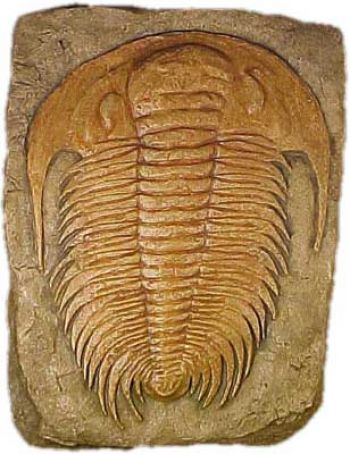
Acadoparadoxides briareus from the Cambrian of Morocco.
Trilobites are very well-known, and possibly the second-most famous fossil group after the dinosaurs. There are over 17,000 species of trilobites. The name "trilobite" (meaning "three-lobed") is not based on the body sections cephalon, thorax and pygidium, but rather on the three longitudinal lobes: a central axial lobe, and two symmetrical pleural lobes that flank the axis.
Trilobites are extinct arthropods that form the class Trilobita. They appeared in the Cambrian period and flourished throughout the lower Paleozoic era before beginning a drawn-out decline to extinction when, during the Late Devonian extinction, all trilobite orders, with the sole exception of Proetida, died out. The last of the trilobites disappeared in the mass extinction at the end of the Permian about 250 million years ago (m.y.a.).
Trilobites range in length from one millimeter to 72 cm (1/25 inch to 28 inches), with a typical size range of two to seven centimeters (1 to 3� inches). The world's largest trilobite, Isotelus rex, was found in 1998 by Canadian scientists in Ordovician rocks on the shores of Hudson Bay.
Resin Cast
11.5x8.5 trilobite 13x9.5
Item 268
Category: Replicas
Type: Skeletons
Phylum: Invertebrates
Class: Trilobites

Now Over 1,000 Items!
PrehistoricStore.com offers the largest selection of replica fossils and other fossil-related products anywhere in the world!
Download a Full Catalog (3MB PDF)
OVER 260 PAGES OF REPLICAS AND MORE!
